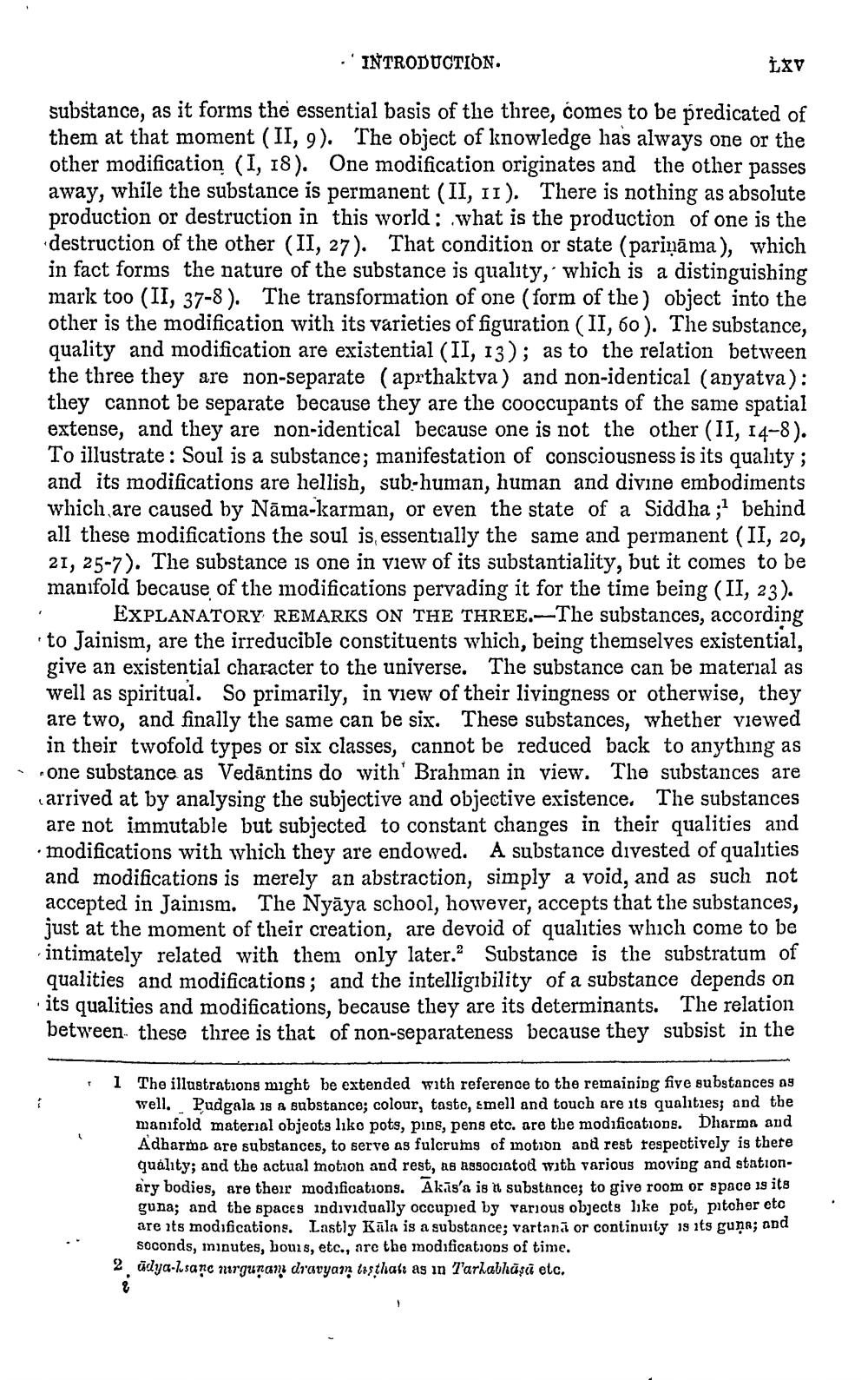________________
.'INTRODUCTION.
LXV
substance, as it forms the essential basis of the three, comes to be predicated of them at that moment (II, 9). The object of knowledge has always one or the other modification (I, 18). One modification originates and the other passes away, while the substance is permanent (II, 11). There is nothing as absolute production or destruction in this world: what is the production of one is the destruction of the other (II, 27). That condition or state (pariņāma), which in fact forms the nature of the substance is quality, which is a distinguishing mark too (II, 37-8). The transformation of one (form of the object into the other is the modification with its varieties of figuration (II, 60). The substance, quality and modification are existential (II, 13); as to the relation between the three they are non-separate (aprthaktva) and non-identical (anyatva): they cannot be separate because they are the cooccupants of the same spatial extense, and they are non-identical because one is not the other (II, 14-8). To illustrate : Soul is a substance; manifestation of consciousness is its quality ; and its modifications are hellish, sub-human, human and divine embodiments which are caused by Nāma-karman, or even the state of a Siddha ;? behind all these modifications the soul is essentially the same and permanent (II, 20, 21, 25-7). The substance is one in view of its substantiality, but it comes to be manifold because of the modifications pervading it for the time being (II, 23).
EXPLANATORY REMARKS ON THE THREE.-The substances, according to Jainism, are the irreducible constituents which, being themselves existential, give an existential character to the universe. The substance can be material as well as spiritual. So primarily, in view of their livingness or otherwise, they are two, and finally the same can be six. These substances, whether viewed
in their twofold types or six classes, cannot be reduced back to anything as - one substance as Vedāntins do with Brahman in view. The substances are
arrived at by analysing the subjective and objective existence. The substances are not immutable but subjected to constant changes in their qualities and ·modifications with which they are endowed. A substance divested of qualities and modifications is merely an abstraction, simply a void, and as such not accepted in Jainism. The Nyāya school, however, accepts that the substances, just at the moment of their creation, are devoid of qualities which come to be intimately related with them only later.2 Substance is the substratum of qualities and modifications; and the intelligibility of a substance depends on its qualities and modifications, because they are its determinants. The relation between these three is that of non-separateness because they subsist in the
1 The illustrations might be extended with reference to the remaining five substances as
well. , Pudgala is a substance; colour, taste, Emell and touch are its qualities; and the manifold material objeots liko pots, pipe, pens etc. are the modifications. Dharma and Adharma are substances, to serve as fulcrums of motion and rest respectively is there quality; and the actual motion and rest, as associatod with various moving and stationary bodies, are their modifications. Akūs'a is a substances to give room or space is its guna; and the spaces individually occupied by various objects like pot, pitcher etc are its modifications. Lastly Kāla is a substance; vartand or continuity is its guna; and
soconds, minutes, bous, etc., are the modifications of time. 2. ūdya-lusaņe nurgunam dravyan Listhatı as in Tarlabhūşti etc.




